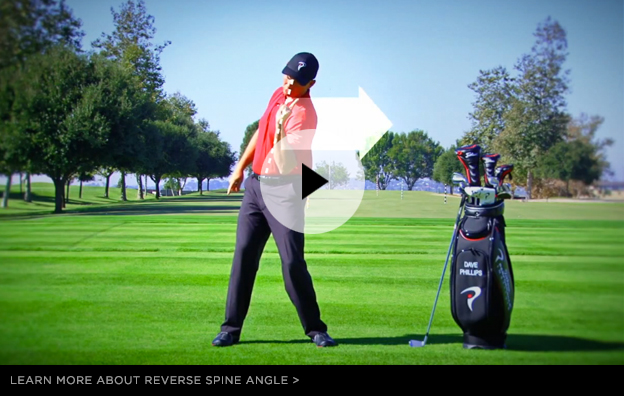IMPROVE MY GAME
Articles
The Golfer's Guide to Lower Back Pain – Part 1

Lower back pain is by far the most common ailment suffered by golfers of all ages. Based on data collected at TPI from over 31,000 golfers, 28.1% of all players deal with lower back pain after every round. Lower back pain is also the most common complaint seen amongst professional golfers on all tours (data suggest over 23% play with lower back pain). To understand the cause of lower back pain, it requires a thorough investigation of what I call the Body-Swing Connection™. Let’s take a closer look.
First of all, let me start by making a bold statement. The lower back is rarely the original cause of the pain! It may be the current source of the pain, but it’s rarely the cause of the pain. More often than not, abnormal motions or forces coming from adjacent or distant areas of the body force the lower back to do excessive work until it completely breaks down itself. In other words, the lumbar spine is usually the area that is being unnecessarily overworked to the point of injury. It is basically the over-used and over-abused worker who just goes and goes until he or she breaks.
In my experience, the lack of mobility seen in the ankles, hips, thoracic spine and shoulders of many golfers forces the lower back to carry all of these excessive loads and is the primary cause for most back injuries. So any article about lower back pain should address those areas specifically.
When the lower back finally does break down, you can typically expect one of the following conditions to occur:
- Muscle Strain or Ligamentous Sprain - A muscle strain or “pulled muscle” as well as an injured ligament will usually resolve itself in 2-4 weeks with plain old rest and recovery. However, there can be some residual muscle stiffness, fascial restrictions, joint fixations or movement alterations that may need to be addressed afterwards. Sprains or strains are the most common form of lower back injury we see. Symptoms may range from a minor ache to a sharp debilitating pain. Most sprains and strains are localized in the lower back region, meaning pain does not radiate into the butt or leg. The chemical inflammation around the injury is usually sore to the touch and the pain usually subsides with rest.
- Disc Injury - The lumbar intervertebral disc acts as a spacer between adjacent vertebrae to help absorb compressive forces and create space for the spinal nerves to exit the spinal column. Imagine the disc as a jelly filled donut. If excessive or abnormal stressors are placed on the disc, tears can occur. When this happens, the force of the jelly against that tear can cause a bulge in a portion of the donut leading to a “bulged disc.” In more severe cases, the jelly can actually exit through the donut wall leading to a “ruptured disc.” The discs are also susceptible to degenerative changes over time. To continue the analogy, imagine the jelly inside of the donut drying up. Any of these disc problems can leave the spinal nerves vulnerable to irritation or compression resulting in dysfunction and pain. Most disc pathologies create radiating pain into the buttocks or the leg (think sciatica) due to the irritation of spinal nerves. Sitting for prolonged periods of time, bending forward into a slouched position, or lifting heavy objects can all exacerbate disc symptoms.
- Altered Joint Mechanics or Motor Control - Interestingly, the brain can completely change the lumbar spine’s ability to move just by changing which muscles are firing or by altering the sequence of when muscles fire. This can occur in the absence of any visible injury. These altered motor control or joint mechanics can begin as a protective mechanism, but can lead to chronic problems over time. Most experts believe over 80% of all chronic lower back problems begin this way.
- Degenerative Arthritis - Just like all joints, with over-use, abuse, or even lack of use, spinal joints can become arthritic. Bone spurs and osteophytes act like stalactites and stalagmites inside a cave closing in on the opening for the spinal nerves. With time, these bony outgrowths can fuse joints, irritate nerves and create general inflammation in the area. Stenosis, the narrowing of the canal or cave that houses the spinal nerves is a very common problem with arthritic changes. Most arthritic problems in the spine create sharp pain with certain movements. The resulting inflammation can then cause chronic dull pain over time.
- Bone Fracture - Stress fractures and pedicle fractures (spondylolysis) are common problems seen in the lumbar spines of rotational athletes. This occurs due to the rapid extension and rotation of the spine, causing adjacent vertebrae to collide into each other at their end range of motion. This action places high forces on the posterior portions of the vertebrae and can lead to these types of fractures. Injuries of this sort can lead to deep dull pain and instability in the spine.
So the big questions are:
- How do I prevent the lower back from getting injured?
- How do I treat the injury once it occurs?
Let’s start by talking about prevention. The best way to prevent lower back injuries in golf is to attack the problem head on with three main offensives:
- Normalize Movement Patterns
- Optimize Swing Mechanics
- Incorporate Recovery Techniques
Normalize Movement Patterns
The first line of defense against lower back pain is to create optimal movement patterns in the areas directly above and below the lumbar spine - the hips and thoracic spine. The golf swing requires great rotational mobility to develop and transfer energy to the club. That mobility should come from the joints in the body that are designed to rotate, the hips and the thoracic spine. If you study the anatomy of the lumbar spine, you will see that the spinal joints, called facets, are orientated to allow flexion and extension, not rotation. If the lower back is forced to be a primary rotator due to a lack of hip and thoracic mobility, it's only a matter of time before an injury will occur in the lumbar spine. It is important to remember that the hips and thoracic spine do not operate in isolation. Abnormal motion in the ankle can cause poor hip motor control. And poor motion in the shoulder can cause poor thoracic spine motor control. Therefore, we can’t neglect the ankle or shoulder joints in our assessments.
So in order to unravel the mystery of why someone has lower back pain, we must first evaluate the movement patterns of all the surrounding areas. At TPI, we use a combination of our basic TPI assessment screen and the SFMA (Selective Functional Movement Assessment) to identify any of these altered movement patterns and make a true starting diagnosis. Once the dysfunction has been identified, we attack all mobility restrictions first and then create the stability required to normalize motor control. When the areas above and below the lumbar spine are functioning properly, the lumbar spine can gain some much-needed rest. Once normal movement patterns are optimized, a solid conditioning program is the best form of prevention. We encourage all players to build a solid base of strength and to maintain proper mobility in order to keep their lower back healthy for a lifetime.
Optimize Swing Mechanics
When it comes to optimizing swing mechanics, it is easy to see how some common swing characteristics can induce abnormal stressors into the lower back. The most common characteristic is Reverse Spine Angle (RSA). This is usually caused by a lack of rotary mobility in the hips and thoracic spine causing the lumbar spine to extend excessively in order to pick up some much needed range of motion. Because RSA puts excessive extension in the spine at the top of the backswing, the player must excessively flex and right side bend to get back to impact, a bad combination. This combination of movements has been proven to add compressive and shear stress to the lumbar spine. My saying for Reverse Spine Angle goes like this, “It’s not if you’re going to get lower back pain, it’s when are you going to get lower back pain!” Learn more about Reverse Spine Angle below.
The second most common swing characteristic that can lead to lower back problems is S-Posture. This is typically a set-up problem and often begins before the player even takes the club back. S-Posture places the lumbar spine into something called the Lower Crossed Syndrome Pattern. This is an extremely common postural adaptation to muscle imbalances created by prolonged static postures, like sitting at a desk for years on end. With Lower Crossed Syndrome, the abdominal and gluteal (stomach and butt) muscles become inhibited or weak due to over-activation or tightness in the hip flexors and lower back. Due to this imbalance in the muscles surrounding the lumbar spine, excessive stress is placed on the structures of the lower back. S-Posture also helps encourage Reverse Spine Angle since the lumbar spine is already excessively extended at the start of the swing. Learn more about S-Posture below.
The third most common swing characteristic that can lead to lower back issues is called Hanging Back. Hanging Back can force a player to excessively right side bend through impact. This can put added stress onto the right side of the lumbar spine and lead to lower back injuries. Some players hang back or add right side bend in an attempt to open the clubface through impact. This is a very common compensation for a closed clubface in the golf swing. Additionally, many players with lower back pain can become tentative in their swing and may exacerbate the problem by not properly shifting weight forward in the downswing, hanging back instead. Learn more about Hanging Back below.
As you can see, a thorough evaluation of a player’s swing mechanics is imperative in order to properly understand the injury mechanism. We always combine our physical exam with a swing exam to try and make this Body-Swing Connection.
Some of the most common swing modifications that we recommend for eliminating back pain are the following:
- Neutral Posture - Now that you understand how Reverse Spine Angle and S-Posture can lead to lower back injury, it is easy to see how getting a player into a neutral spine posture can dramatically help stabilize their spinal mechanics. See below our favorite set-up drill for neutral posture: Neutral Pelvis Forward Bends. Maintaining a neutral spine posture during the backswing is also critical. Many players go into excessive extension in the lumbar spine mid-way through the backswing and then continue that extended position into the top of the swing (creating Reverse Spine Angle). Below is our favorite drill to help prevent that pattern: Pubic Bone to Rib Cage
- Lead Hip High - One of the easiest ways to encourage a Reverse Spine Angle is to allow the player to set up with their trail hip higher than their lead hip. If a right-handed player gets their right hip higher at set-up, it tends to encourage a lateral sway away from the target in the backswing, which usually tilts the spine towards the target at the top of the swing. The goal of all players with lower back pain should be to set up with a level pelvis or the lead hip slightly higher than the trail hip. Below is our favorite drill to assist with this: Lead Hip High Lead Shoulder Low
- Forward Ball Position - Players who Hang Back or who have Reverse Spine Angle tend to place the ball back in their stance. To eliminate this, exaggerate a forward ball position. This will encourage the player to shift weight forward and not hang back during the downswing. This forward weight shift is a key move that can reduce the amount of right side bend through impact.
- Eliminate the Sway - As stated earlier, any movement away from the target (Sway) in the backswing, can lead to Reverse Spine Angle at the top. To help eliminate a sway try this drill below: Reach Over the Fence.
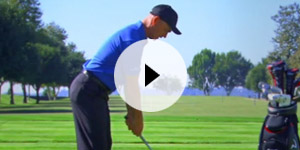
Neutral Pelvis Forward Bends
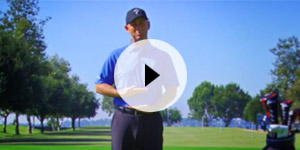
Pubic Bone to Rib Cage
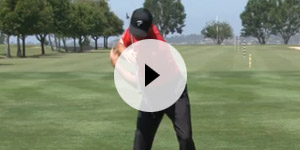
Lead Hip High Lead Shoulder Low
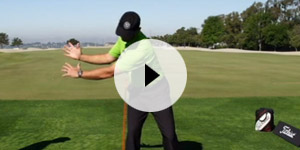
Reach Over the Fence
Incorporate Recovery Techniques
The last form of preventative action that should be encouraged is incorporating recovery techniques into a player’s normal after-round routine. Recovery techniques will help reduce inflammation, restore normative motor control and repair muscle and joint damage sustained during the round. Basic forms of recovery include the following:
Hot and cold therapy - This includes ice packs, cold plunges, cryotherapy, heating pads, hot packs, hot tubs, sauna, steam rooms, etc. All of these methods can help make a difference after a round. Experimentation with alternative methods may be necessary to find the best combination for each player.
Massage - This is one of the best ways to reduce soreness, flush inflammation and revitalize the soft tissue.
Nutritional Support - There are many nutrients that can help reduce soreness, repair muscle damage and control inflammation. After four or five hours of playing golf, the body is in a slightly depleted and catabolic (tissue destructive) state. At this time, it is critical to eat the right type of foods to help facilitate recovery of muscles, tendons and ligaments. A player can feel dramatically better the next day by simply adding a post round recovery shake or incorporating proper dietary recommendations. We encourage players to immediately replenish their carbohydrates to help reduce soreness and to add some protein to help repair muscle and tendon damage. Drinking plenty of water is also a great recovery technique. Dehydration after a round can lead to next day soreness and muscle fatigue.
Sleep - One of the most important recovery techniques that I can’t stress enough is a minimum of eight hours of sleep. This is when the body repairs and rebuilds. Without that necessary sleep, most players will wake up sore.
Recovery Exercise - Many exercises can help aid recovery. Stretching is a great example of an exercise that can help re-establish normal motor control after a round.
Now let’s shift our attention to some actions that can be taken if, unfortunately, you already have a lower back injury. I will discuss each of the major types of injuries and options available for treatment. Remember, the preventative actions discussed above should also be incorporated into the treatments below.
Muscle Strains
Treatment of muscle strains should focus on controlling the initial inflammation and restoring proper muscle, joint and ligamentous function. Typical treatment protocols include some combination of the following:
Manual Therapy - Chiropractic, physical therapy, osteopathy, massage, and other manual therapy techniques can be extremely effective in reducing the recovery time for muscle strains and ligamentous sprains. These options help promote proper blood flow in the lower back (to help with healing), loosen tight lower back muscles, maintain proper joint mechanics, and aid in the release of endorphins, the body’s natural painkillers. All of these things promote accelerated healing in the lower back.
Cold Therapy (Cryotherapy) - The application of cold packs over the injured area can dramatically help numb the tissues and may relieve muscle spasms or associated inflammation. Cold can be applied using an ice or gel cold pack, cold plunge pools, cryotherapy chambers (which use liquid nitrogen to cool the room) or topical sprays (such as ethyl chloride) that cool by evaporation. Do not apply cold to tissues with an already reduced blood supply (for example, when the arteries are narrowed by peripheral arterial disease).
Electrical Stimulation - Electrical stimulation via electrodes placed on the skin has been used to help speed recovery for years. Electrical stimulation can increase nervous system activity and stimulate fluid circulation resulting in reduced inflammation. One form of electrical stimulation called transcutaneous electrical nerve stimulation (TENS) uses a low current that does not cause muscles to contract. The device produces a tingling sensation but is not painful.
Heat Therapy - Heat increases blood flow and can temporarily decrease joint stiffness, pain, and muscle spasms. Hot packs, infrared heat, paraffin baths, and hydrotherapy provide surface heat. High-frequency sound waves (ultrasound) can also be used to generate heat in deep tissues.
Acupuncture - This involves treating various points on the body using several methods such as the insertion of thin needles, application of heat, applying pressure or laser light therapy. Traditional acupuncture involves needle insertion, moxibustion (burning of a Chinese herb) and cupping therapy. This is a fundamental component of traditional Chinese Medicine (TCM) that has been used for over 5,000 years. According to TCM, the stimulation of specific acupuncture points corrects imbalances in the flow of Qi (chi) through channels known as meridians. By balancing the body’s qi, healing is accelerated. Acupuncture should be done by a certified acupuncturist and with sterile needles.
Rest & Recovery - Often, muscle strains just need a few days of TLC. However, when I say rest, I don’t mean someone should remain 100% bedridden. Reduction of workload, not lifting heavy objects, time off from strenuous activities, improvement in workplace ergonomics and modification of poor sleeping habits can usually do the trick. The body has an amazing ability to heal sprains and strains as long as you stop aggravating it. Just remember, light activities such as walking can be very beneficial in accelerating the recovery process.
Anti-inflammatory Medication - Local inflammation that may exacerbate pain can be reduced with the aid of anti-inflammatory medication such as ibuprofen or NSAIDs. Just remember, these medications only reduce the inflammation and do not fix any potential muscle or ligamentous damage that may lie below the inflammation. Be warned, chronic use of NSAIDs can become part of the problem and not part of the solution.
Muscle Relaxants - If muscle spasms are present (which are often associated with muscular strains) these drugs may relieve some of the pain associated with the muscle spasms.
I am not a fan of including the anti-inflammatory or muscle relaxant medications unless it is absolutely needed. If the pain can be tolerated, I feel some of the normal associated inflammation can help speed up the recovery.
Once the pain has subsided, we must investigate why the injury occurred in the first place. In other words, there is usually some underlying altered movement pattern that caused the sprain or strain to happen. We go back to our basic movement screen and the SFMA to make sure the original cause of the problem has been addressed as well as the resulting sprain and strain.
Disc Injuries (Non-Surgical Options)
As we discussed earlier, the intervertebral disc resembles a jelly filled donut. All of the treatment options below focus on reducing the irritation or compression to the spinal nerves created by the abnormal displacement of the jelly. Here are the most common options:
Conservative Rehabilitation - The first line of treatment should always involve a 6 to 12 week trial of either chiropractic, osteopathic, and/or physical therapy. The goals of these types of treatment are to:
- Reduce the inflammation
- Restore normal stability, motor control and motion in the lumbar spine
- Improve mobility in the surrounding joints (hips and thoracic spine)
- Educate the patient on techniques to prevent further episodes such as ergonomics, sleeping positions, proper lifting and carrying techniques, recovery options, etc.
- Supply the patient with an exercise routine to prevent re-injury
Most patients will feel some sort of relief right away. Many successful rehabilitation programs include a combination of many conservative techniques.
Acupuncture - I covered this form of treatment earlier. Personally, I’ve had many patients with disc issues feel significant relief following acupuncture treatments.
Home Distraction - Many people are familiar with “the rack” which was used to stretch people apart as a torture device in medieval times. Well, this is kind of like that, but without the torture part. Often, the nerve pain can be decreased by reducing the compressive forces applied to the vertebrae above and below the disc. Imagine stepping on a jelly donut, shooting the jelly out of the outer wall. If you just take your foot off the donut (thus reducing the pressure), it should stop forcing the jelly out. Home distraction techniques like the types listed below work similar in theory to that.
- Lumbar distraction devices - These are devices that allow the patient to lay down (face up) and separates the upper and lower body. Typically, these devices use some form of air pump or electric motor to slowly increase the amount of distraction to an appropriate tolerance level.
- Inversion devices - Hanging upside down is an age-old technique that can offer relief to some back pain patients. With this form of distraction, the normal compressive forces of gravity are completely reversed in the inverted position.
- Brachiating - Similar in concept to inversion devices but instead of hanging upside down, the patient simply holds onto a pull-up bar with both hands and lifts their feet off the ground. The weight of the patient’s lower body acts as the traction mechanism and helps separate the lower body from the upper body. A weakness with this method is the patient’s own upper body strength, as the patient’s individual ability can limit the amount of time they can support themselves in the hanging position.
Heat and Cold Therapy - As stated earlier, heat and cold therapy can temporarily decreases inflammation, joint stiffness, pain, and muscle spasms. Hot packs, infrared heat, paraffin baths, hydrotherapy and high-frequency sound waves (ultrasound) can all be used in the application of heat. Ice, gel cold packs, cold plunge pools, cryotherapy chambers or topical sprays can all be used to chill the area.
Anti-Inflammatory Drugs - Most disc episodes create swelling around the spine therefore, inflammation is a major contributing factor to the pain. Anti-inflammatory medications such as non-steroidal anti-inflammatory drugs (NSAIDs) are often an effective pain medication treatment option. As stated earlier, this only reduces the inflammation and does not fix the inherent problem that lies below the inflammation.
Epidural Injections or Medrol Dose Pack - If the NSAIDs don't offer relief, either oral steroid medication (Medrol) or an epidural injection around the disc site usually achieves an immediate anti-inflammatory effect. Approximately 50% of the time, an epidural steroid injection will give pain relief that may last from one week up to one year. Most physiatrists recommend a maximum of three epidural injections per calendar year (at least two weeks apart).
Disc Injuries (Surgical Options)
The options for surgical treatments are varied and new experimental treatments are constantly under development as technology advances. The following are the most common surgical options offered today for lumbar spinal pain.
Micro-Discectomy - This is surgery to remove the herniated disc material that is pressing on a spinal nerve root or the spinal cord. Most of these procedures are done today as a micro-discectomy, which uses a special microscope to view the disc and nerves. These tools allow the surgeon to use a smaller incision with minimal or no damage to the surrounding supporting structures. Down time is usually minimal with these procedures and recovery is usually very good. Here is a review of spinal surgery results that looks at the return to athletic activities from some of the foremost spinal surgeons in the country, click PDF below:
Laminectomy - Sometimes, before a discectomy, a small piece of bone (the lamina) from the affected vertebra may be removed. This is called a laminotomy or laminectomy and enlarges your spinal canal to relieve pressure on the spinal cord or nerves and may allow the surgeon better access to the problem area.
Spinal Fusion - When the joint between the two vertebrae is very arthritic or the joint is very unstable, a surgeon may recommend a fusion. A spinal fusion surgery is designed to stop the motion at a painful vertebral segment, which in turn should decrease pain generated from the joint. Often, a bone graft is added to a segment of the spine that will eventually fuse the two vertebrae together. This procedure has a much longer down time, since the patient must wait for the fusion to take and heal.
Disc Replacement - The last and most recent option available is a total disc replacement. This procedure involves replacing the body’s natural disk with an artificial replacement made of metal or a metal/plastic combination. Lumbar disc replacement gained FDA approval in 2004. I have seen some incredible results from this form of treatment and I’m encouraged about future advancement in this option.
In Part 2, I’ll take a closer look at the remaining lower back conditions including altered joint mechanics & motor control, degenerative arthritis and bone fractures. Additionally, I’ll provide some return-to-play protocols and guidelines for those players working through lower back injuries or discomfort.
